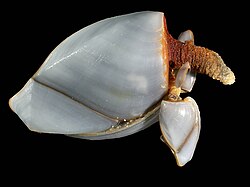- A detached holdfast of Durvillaea antarctica colonised by Lepas australis
- A closer photo of L. australis on the same kelp holdfast
| Lepas | |
|---|---|
 | |
| Lepas anserifera | |
| Scientific classification | |
| Kingdom: | Animalia |
| Phylum: | Arthropoda |
| Class: | Thecostraca |
| Subclass: | Cirripedia |
| Order: | Scalpellomorpha |
| Family: | Lepadidae |
| Genus: | Lepas Linnaeus, 1758 |
| Species | |
see text | |
Lepas is a genus of goose barnacles in the family Lepadidae. [1]

